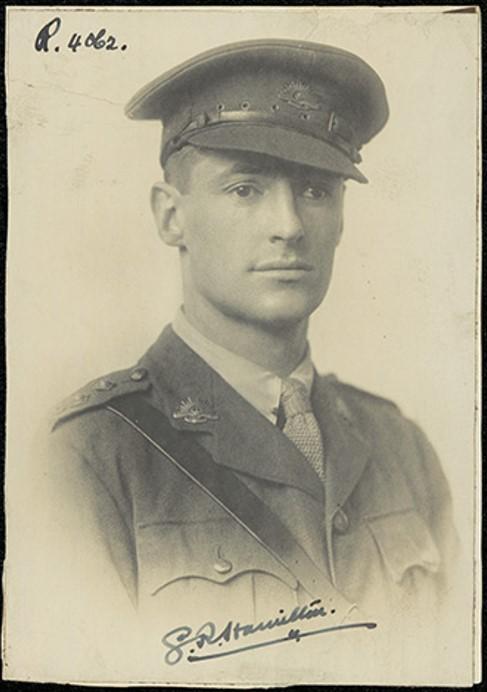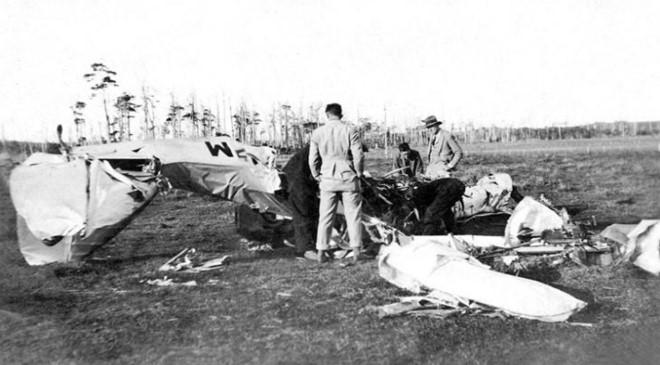In 2020 the Anzac Memorial purchased an Australian Army Medical Corps (AAMC) uniform and a leather saddle with girth strap related to Captain George Redfearn Hamilton, 1st AIF. This is a significant acquisition for the Memorial because both the uniform and the saddle are really rather rare. Moreover, the uniform is the only one in our collection provenanced to an officer.
Promise of a bright future for son of eminent NSW judge
George Redfearn Hamilton was born in Petersham on 13 January 1893. His mother was English-born Minnie Redfearn and his father was the eminent judge and parliamentary draftsman Hugh Montgomerie Hamilton. Hugh Hamilton had a brilliant legal career and was also a keen sportsman and mountaineer, prominent philanthropist and mason, amateur horticulturalist and an obsessive collector of antique china and stamps. As President of the Poultry Club and the NSW Kennel Association he was also a keen judge of chickens and dogs. When he died on 11 August 1930, his funeral at Waverly Cemetery on the following day was attended by hundreds of eminent Sydneysiders.[1]
George Hamilton was educated at Sydney Church of England Grammar School (North Shore) and he later enrolled at the University of Sydney where he gained a medical degree in 1916. Like his father, he was a talented sportsman playing rugby at both school and university and he also rowed for St Pauls College. In ice hockey he played for New South Wales against Victoria. When he enlisted with the Australian Army Medical Corps on 6 November 1916, he had already served twelve months as a Lieutenant with the 25th Voluntary Infantry and was immediately promoted to the rank of Captain.[2]

Photo: George Redfearn Hamilton (National Library of Australia).
On the Western Front
Hamilton embarked from Sydney for England per Ajana in January 1917 and in June he proceeded to France where he was posted to the 1st Australian Field Ambulance. In November 1917 he was attached to the 4th Battalion and transferred to the 1st Machine Gun Battalion in April 1918. He was seriously wounded at Proyart on the Somme on 25 August 1918 with gun-shot wounds to his legs, back and buttocks. Two toes on his left foot were subsequently amputated and he spent the next ten months recuperating in hospital in France and was later invalided to London.

Photo: Australian soldiers digging trenches at Proyart, France, August 1918. AWM H04535.
Hamilton remained in London in 1919 and 1920 where he continued his medical training specialising in skin diseases and dermatology. This further instruction undertaken through the AIF’s non-military employment scheme was, according to the notes in his service record, deemed to be ‘of the utmost value to him on his return to civil life.’ He was officially discharged as medically unfit from the AIF in England in October 1920 and arrived back in Sydney in April 1921 having travelled home via America. Sadly, one of his suitcases of personal effects went missing during the journey home and it was never recovered. Whatever was in that lost luggage, today the curatorial team at the Anzac Memorial can only rue and wonder.
Hamilton's post-war medical and aviation pursuits
After the war, Hamilton became a highly esteemed skin specialist with a private practise at 147 Macquarie Street, Sydney. In the 1920s he was an outspoken critic of the draconian Venereal Disease Act (Act No 46, 1918) arguing instead that that the use of prophylactics was the only effective way of preventing disease transmission.[3] On 5 July 1923 he married Mosman-born Dagmar Louise Quist.[4] Dagmar gave birth to a son on 30 January 1925 and the couple named him after his esteemed grandfather Hugh Montgomery Hamilton. Tragically, just over a week later, on 7 February, Dagmar died. It was exactly two weeks before her 27th birthday and George buried his beloved young wife at Waverly Cemetery. George married twenty-one-year-old Eunice Knight in 1927, however their marriage appears to have been a troubled one, and the couple divorced during the winter of 1932.
During the 1920s, Hamilton, like many Great War veterans and enthusiastic entrepreneurs developed an abiding passion for aviation and the possibilities of flight. According to the Sydney Morning Herald he was ‘one of the most enthusiastic members of the New South Wales Aero Club and lost no opportunity to further the cause of aviation.’[5]
In April 1929 he joined an intrepid team to search for the aviators Charles Kingsford Smith and Charles Ulm and their crew who had gone missing in the north-west Australian desert during a flight on the Southern Cross. They had been attempting to fly across Australia but were forced to make an emergency landing near the Glenelg River in the Kimberley’s. Hamilton’s pilot on the rescue mission was his dear school chum Captain Leslie Hubert ‘Les’ Holden, fighter pilot ace of the Great War, Military Cross recipient and later commercial aviator.
On 18 September 1932, both Hamilton and Holden were travelling on a New England Airways (NEA) Puss Moth monoplane carrying mail from Sydney to Brisbane, when it crashed into a paddock at Bangalow seven miles from Byron Bay in a heavy rainstorm.[6] They were killed instantly together with Ralph Virtue, a distinguished air pilot from Lismore.[7] Within days of the tragic accident, the Cenotaph in Martin Place was elaborately adorned with floral tributes to memorialise their wretched loss, and perhaps also to honour their gallant wartime service.[8]

Photo: Site of the doomed NEA Puss Moth monoplane, image courtesy of Ancestry.
As was usual with accidental deaths, a coroner’s inquest was held into the crash in Byron Bay in October 1932. Walter Henry ‘Wally’ Shiers was the chief engineer at NEA and had been the mechanic on the day of the fatal flight. Shiers had served with the AFC during the Great War and later flew on that first monumental England-Australia flight in a Vickers Vimy with Ross and Keith Smith in 1919. The coroner (Mr. Davidson) concluded that the exact cause of the crash was unknown although the three victims had (somewhat unsurprisingly) ‘died from injuries accidentally received.’[9] Later, a stained-glass window was erected in the Shore Chapel at Sydney Grammar School in memory of former pupils, life-long friends, and Great War veterans Hamilton and Holden.[10]
Hamilton's son enlists with the RAAF during the Second World War
Following Hamilton’s untimely death, his unmarried sister Dr Marie Montgomery Hamilton (1891-1955) who resided in Strathfield, raised her orphaned nephew. Marie Hamilton’s fiancé had been killed at Lone Pine, Gallipoli and in 1918 she entered the faculty of medicine at the University of Sydney and resided in the Women’s College, later working as a resident medical officer at the Royal Prince Alfred Hospital. Like her brother, she developed a particular interest in the treatment of venereal diseases and in 1927 established a clinic for women and children in Redfern. In 1943 she became the first women elected to the council of the NSW branch of the British Medical Association.[11]
That year her eighteen-year-old nephew and George’s son Hugh Montgomery Hamilton enlisted with the RAAF on 25 February. He served as Flying Officer 433101 with 271 Squadron in England, and performed vital flying operations over France.[12] After the war, Hugh married Elizabeth Anne Lehtbridge and like many returned RAAF servicemen, worked as a commercial pilot. Despite our best efforts, we have been unable to ascertain if the couple had any children.[13]
That George Redfearn Hamilton’s Great War medical uniform has survived is quite remarkable, although sadly, we don’t know why he came to possess the Great War saddle. Maybe it was his, perhaps he simply souvenired it, or did it belong to his mates Wally Shiers or Ross Smith who both served as Light Horse men before joining the Australian Flying Corps? We will probably never know but at this historical juncture, we can at least wonder.
Endnotes
- ‘Judge Hamilton’, Sydney Morning Herald, Wednesday 13 August 1930, p 17.
- His mechanical engineer brother John (also a Grammarian and Sydney University graduate) had enlisted in 1914 and in August 1915 he was promoted to Major. By the end of John Hamilton’s war, he was a DSO and had been Mentioned in Despatches four times.
- https://legislation.nsw.gov.au/view/pdf/asmade/act-1918-46.
- ‘Personalities’, The Sun, Thursday 5 July 1923, p 13.
- ‘Air Disaster’, Sydney Morning Herald, Monday 19 September 1932, p 9.
- The Puss Moth was produced between 1929 and 1933. It was however plagued by a series of fatal crashes and was later replaced by the lighter Leopard Moth.
- ‘Air Disaster’, Sydney Morning Herald, Monday 19 September 1932, p 9.
- ‘In Memory of Dead Fliers’, Sydney Morning Herald, Wednesday 21 September 1932, p 14.
- ‘Byron Bay Plane Crash’, The West Wyalong Advocate, Friday 14 October 1932, p 1.
- Built in 1914 in recognition of the School’s 25th anniversary, the Shore Chapel was opened on 4th May 1915 only a few days after the Gallipoli landings. Casualty lists brought the sad news that many Shore boys were among the fallen. The war continued for another three and a half years and the School Chapel became a memorial to all the Old Boys who lost their lives between 1914 and 1918 - and indeed those who lost them later.
- See https://adb.anu.edu.au/biography/hamilton-marie-montgomerie-10404.
- Hamilton was discharged from the RAAF on 23 January 1946.
- Hugh Hamilton died in 2002.
